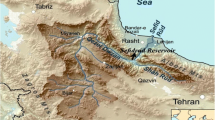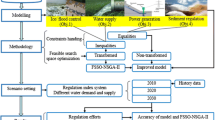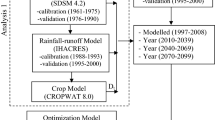Abstract
The aim of this paper is to develop a methodology based on coupled simulation-optimization approach for determining filling rules for the proposed Mandaya Reservoir in Ethiopia with minimum impact on hydropower generation downstream at Roseires Reservoir in Sudan, and ensuring power generation at Mandaya Reservoir in Ethiopia. The Multi-Objective Optimization (MOO) approach for reservoir optimization presented in this paper is a combination of simulation and optimization models, which can assist decision making in water resource planning and management (WRPM). The combined system of reservoirs is set in MIKE BASIN Simulation model, which is then used for simulation of a limited set of feasible filling rules of the Mandaya reservoir according to the current storage level, the inflow, and the time of the year. The same simulation model is then coupled with Multi-Objective optimization Non-dominated Sorting Genetic Algorithm (NSGA-II), which is adopted for determining optimial filling rules of the Mandaya Reservoir. The optimization puts focus on maximization of hydropower generation in both the Mandaya and the Roseires Reservoirs. The results demonstrate that optimal release- (and correspondingly filling-) rules for Mandaya Reservoir which maximize the hydropower generation in both Mandaya and Roseires reservoirs can be found. These rules are determined along the Pareto frontier obtained by the optimization algorithm, which can serve as a decision support tool for choosing the actual filling rule. The results also showed that the NSGA- II is an efficient and powerful tool that could assist decision makers for solving optimization problems in complex water resource systems.










Similar content being viewed by others
References
Ahmed J, Sarma A (2005) Genetic algorithm for optimal operating policy of a multipurpose reservoir. Water Resour Manag 19:145–161
Azamathulla H, Wu F-C, Ghani AA, Narulkar SM, Zakaria NA, Chang CK (2008) Comparison between genetic algorithm and linear programming approach for real time operation. J Hydro-environ Res 2:172–181
Barreto WJ, Price RK, Solomatine DP, Vojinovic Z (2006) Approaches to Multi-Objective Multi-Tier Optimization in Urban Drainage Planning. Proceedings to 7-th Conference in Hydroinformatics, Nice, France
Celeste A, Suzuki K, Kadota A (2004) Genetic algorithms for real-time operation of multipurpose water resource systems. J Hydroinform 6:19–38
Chang L-C (2008) Guiding rational reservoir flood operation using penalty-type genetic algorithm. J Hydrol 354:65–74
Chen L (2003) Real coded genetic algorithm optimization of long term reservoir operation. J Am Water Resource Assoc 39(5):1157–1165
Cristiano C, Victoria CPC, Aihong W (2006) Optimization of a large-scale water reservoir network by stochastic dynamic programming with efficient state space discretization. Eur J Oper Res 171:1139–1151
Deb K (2002) Multi-objective optimization using evolutionary algorithms. Wiley, Chichester, pp 81–112
Deb K, Pratap A, Agrawal S, Meyarivan T (2002) A fast elitist muti-objective genetic algorithm NSGA-II. IEEE Trans Evol Comput 6:182–197
East V, Hall MJ (1994) Water resource system optimizatiom using genetic algorithms. In: Proccedings of the first International Conference on hydroinformatics, Baikema, Rotterdam, The Netherlands. pp 225–31
Hakimi-Asiabar M, Ghodsypour SH, Kerachian R (2010) Deriving operating policies for multi-objective reservoir systems: application of self-learning genetic algorithm. Appl Soft Comput 10:1151–1163
Joshi GS, Gupta K (2009) A simulation model for the operation of multipurpose multireservoir system for River Narmada, India. J Hydro-environ Res 3:96–108
Kim T, Heo JH (2004) Multi-reservoir system optimization using multi-objective genetic algorithms. In: Proceeding of the World Water and Environmental Resources Congress, 27th Jun to 1st Jul. WERI, ASCE, Salt Lake City UT, pp. 1–10
Lane WL, Frevert DK (1990) Applied stochastic techniques. Personal computer version 5.2, User’s manual. Earth science Division, U.S.Bureau of Reclamation, Denever
Loucks D, Stedinger J, Haith D (1981) Water resource systems planning and analysis. Prentice-Hall, Englewood Cliffs, p 559
Mays L, Tung Y (1992) Hydrosystems engineering and management. McGraw-Hill, New York
Mohan S, Raipure DM (1992) Multiobjective analysis of multireservoir system. J Water Resour Plan Manag 118(4):356–370
Needham JT, Watkins DW, Lund JR (2000) Linear programming for flood control in the Iowa and Des Moines rivers. J Water Resour Plan Manag 126(3):118–127
Ngo LL, Madsen H, Rosbjerg D (2007) Simulation and optimisation modelling approach for operation of the Hoa Binh reservoir, Vietnam. Journal of Hydrology, 336(3–4):269–281
Oliveira R, Loucks DP (1997) Operating rules for multi-reservoir systems. Water Rescour Res 33(4):839–852
Sharif M, Wardlaw R, (2000) Multi-reservoir system optimization using genetic algorithms case study. J. Comp. Civ. Eng. ASCE. 14(4):255–263
Solomatine D, Avila Torres LA (1996) Neural network approximation of a hydrodynamic model in optimizing reservoir operation. In: Proc. of the 2nd Int. Conf. on Hydroinformatics, Zurich pp. 201–206
Soncini-Sessa R, Cellina F, Pianosi F, Weber, (2007) Integrated and participatory water resources management—practice. Elsevier, p 405
Yeh W (1981) Reservoir management and operation models: Astae-of-the-Art review. Water Resour Res 21:1797–1818
Author information
Authors and Affiliations
Corresponding author
Rights and permissions
About this article
Cite this article
Hassaballah, K., Jonoski, A., Popescu, I. et al. Model-Based Optimization of Downstream Impact during Filling of a New Reservoir: Case Study of Mandaya/Roseires Reservoirs on the Blue Nile River. Water Resour Manage 26, 273–293 (2012). https://doi.org/10.1007/s11269-011-9917-8
Received:
Accepted:
Published:
Issue Date:
DOI: https://doi.org/10.1007/s11269-011-9917-8




